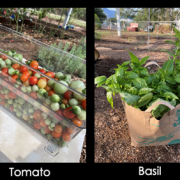Tasting the Fruits and Vegetables Grown Under Solar Panels
By: Mariah Rogers, Graduate Student, University of Arizona
Do plants taste different under solar panels? Do they taste better? At the Biosphere 2 Agrivoltaics Learning Lab, we studied just that.
Why Should We Use Agrivoltaics?
Agrivoltaics—the production of agriculture and solar photovoltaic energy on the same parcel of land—is gaining attention as farmers are facing new struggles amid the climate crisis. With agrivoltaics, farmers can reduce water consumption, produce renewable energy, and continue to cultivate their land. However, there is skepticism toward growing crops under solar panels, as farmers may have to change the types of plants that are more shade tolerant.
The Biosphere 2 Agrivoltaics Learning Lab
At the Biosphere 2 Agrivoltaics Learning Lab (B2AVSLL), we study the microclimate—that localized environment under the solar panels— and how plant adaptations occur in the shade of the agrivoltaic system. Some of the adaptations that plants make in the agrivoltaic microclimates include differences in yield, changes to plant morphology (leaf size, fruit shape and color), and alterations in metabolites. These adaptations may cause differences in how people perceive these crops. To study these differences, we grow a slew of different crops underneath solar panels.

We grow tomatoes, basil, potatoes, beans, squash, and lavender, just to name a few. While some of the plants grown at B2AVSLL are heat tolerant, crops grown in this region of the U.S. still require a lot of water. With agrivoltaics, we can reduce water consumption and still have a good yield. So, it is in our best interest to figure out if they would be successful both for the environment and in the market.

The Study Goals
To understand how these crops would do in the market, we conducted a consumer sensory study at the University of Arizona. The three goals of the study were to: (1) to understand if people perceived a difference between agrivoltaic-grown crops vs. crops grown in full sunlight (control); (2) determine if people preferred agrivoltaic-grown crops compared to control; and (3) discover if people were willing to pay more for crops grown in agrivoltaic conditions.
A total of 105 people participated in the study. Panelists were subjected to different conditions and samples, based on the site and the day they were tasting samples. Tomato and basil, potato and bean, and potato and squash were tasted by panelists.
Does Agrivoltaics Change the Flavor of Plants?
To understand if there was a difference between agrivoltaic- and control-grown samples, we used a triangle test where participants were given three samples with a random three-digit code; two of the samples were the same and one was different. We then asked the participants to pick which sample was the “odd one out.”
So, did agrivoltaics change the flavor of the crops? Yes and no. Tomato, bean, and squash samples (all fruits) were perceived as different by tasters. Basil and potato samples were not perceived as significantly different by tasters.

Does Agrivoltaics Make Plants Taste Better?
To understand if there was a preference between samples from the two growth conditions, we then conducted a paired preference test. We gave tasters two samples with random three-digit codes and asked if they preferred one sample more than another, or if they preferred neither sample.

Unsurprisingly, the results were mixed. People significantly preferred beans grown in the control setting over those grown in agrivoltaics. In addition, agrivoltaic-grown basil, potato, and squash samples were preferred by tasters.
Are People Willing to Pay More for Agrivoltaic-grown Produce?
After the triangle and preference tests, we asked participants if they would be willing to pay more or less for their favorite samples. Overall, we found that participants were willing to pay the same or more for all samples after they knew that their favorite samples were grown in agrivoltaic systems.
What Does This Mean for Farmers and Investors?
Because consumers can’t tell a significant difference in vegetable samples, and they preferred basil, potato, and squash, it may be in farmers’ best interest to grow these crops, especially in the desert. By marketing the produce as grown under solar arrays, and educating consumers about agrivoltaics, farmers may be able to sell their produce for slightly more at farmers markets.
What Does This Mean for You as a Consumers?
Buying for foods that are grown using agrivoltaics means supporting solar energy generation through purchasing fruits or vegetables. If you already go to the farmers market to buy fruits and vegetables, you may want to consider buying agrivoltaic-grown produce. If you want something that tastes like what you already buy from the farmers market, then you may want to buy vegetables. If you are looking for a different tasting product, you may want to buy fruits grown under agrivoltaics. You can be the judge whether you prefer one growth condition over another.



